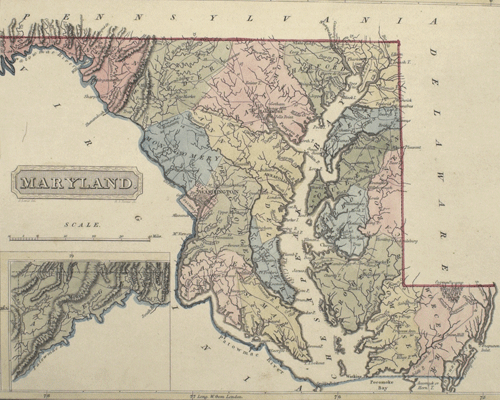
On April 28, 1788, the Maryland Legislature, by a vote of 63 to 11, became the seventh state to ratify the new proposed national Constitution.
With the creation of Allegany on December 25, 1789, the number of counties in Maryland increased to nineteen, a number that stayed constant until 1837. In addition, Baltimore and Annapolis were classified as cities.
Maryland had three Legislative bodies. The House of Delegates, which was elected annually in October, had eighty members; four were chosen at large from each county and two from both Baltimore City and Annapolis.
A State Senate of fifteen members was chosen every five years in early September and by an unusual method. An Electoral College of forty members was chosen, consisting of two members from the counties and one each from Baltimore City and Annapolis. The Electoral College then voted to elect nine Senators to represent the Western Counties and six for what was termed the Eastern Shore. There was not much interest in these elections until 1801, when for the first time; they became a political contest between the Federalist and Republican parties.
In addition to the above, a Governor’s Council of five members was elected annually by a joint session of the House of Delegates and State Senate. They assisted the Governor who was also chosen yearly by the Legislature.
Since the House of Delegates and State Senate voted together in electing the Governor, United States Senators and Governor’s Council, a potentially difficult situation could arise, if control of these two bodies was split between both parties. This played out in the election of 1800, when for the first time, Republicans won control of the House of Delegates, but Federalists still controlled the State Senate. As a result, the Federalists were able to elect their Governor, United States Senator and the entire Governor’s Council, even though Republicans had clearly won the state election.
Popular elections were held in Maryland for Congress, Presidential Electors, House of Delegates, State Senator Electors and County Sheriff. After the elections of 1788 and 1792, all Congressmen and Presidential Electors were chosen by districts. In addition, popular elections for city officers were held in Baltimore and Annapolis.
Except for the overwhelming Republican vote from Baltimore City, the parties were over all fairly evenly matched. After losing control of the state in 1801, the Federalists stayed relatively competitive and were able to rebound and capture the House of Delegates in 1808, and again from 1812–1817. Their greatest victory came in 1816 when they elected five out of nine congressmen, all fifteen State Senators, and had a 56 to 24 edge in the House of Delegates.
With their large majorities in the House of Delegates after 1812 and then by winning the State Senate in 1816, the Federalists were able to elect their Governors and Council members from 1812–1818 along with two United States Senators, one in 1813 and another in 1816. For several years they were in complete control of the Maryland Government.
By 1819 the Federalists lost their majority in the House of Delegates and two years later the entire State Senate. Only fourteen Federalists were elected to the House of Delegates in 1823. However, the following year in an unexpected turn of events, Federalists ran candidates in seven of the eight congressional contests, electing three members and losing another by running two candidates, splitting their votes, thus allowing a Republican to win. Voter turnout for this election was the highest ever cast in Maryland. It was perhaps a precursor to the changing political scene that was about to engulf the nation.
- "State History", Maryland, Things to do.com, (2006)Software Solutions
- Archives of Maryland Historical List Maryland Government






